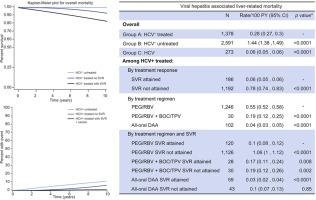当前位置:
X-MOL 学术
›
J. Hepatol.
›
论文详情
Our official English website, www.x-mol.net, welcomes your feedback! (Note: you will need to create a separate account there.)
Treatment of HCV reduces viral hepatitis-associated liver-related mortality in patients: An ERCHIVES study
Journal of Hepatology ( IF 25.7 ) Pub Date : 2020-08-01 , DOI: 10.1016/j.jhep.2020.02.022 Adeel Ajwad Butt 1 , Peng Yan 2 , Obaid S Shaikh 2 , Vincent Lo Re 3 , Abdul-Badi Abou-Samra 4 , Kenneth E Sherman 5
Journal of Hepatology ( IF 25.7 ) Pub Date : 2020-08-01 , DOI: 10.1016/j.jhep.2020.02.022 Adeel Ajwad Butt 1 , Peng Yan 2 , Obaid S Shaikh 2 , Vincent Lo Re 3 , Abdul-Badi Abou-Samra 4 , Kenneth E Sherman 5
Affiliation

|
BACKGROUND/AIMS
Treating hepatitis C virus (HCV) infection reduces overall mortality and reduces the risk of multiple extrahepatic complications. Whether the reduction in mortality is primarily due to reduction in liver-related causes or extrahepatic complications is unknown. METHODS
We identified HCV+ persons treated for HCV, and propensity-score matched HCV+/untreated and HCV-uninfected persons in ERCHIVES between 2002-2016. We extracted cause of death data from the National Center for Health Statistics' National Death Index. Viral hepatitis associated liver-related mortality rates among treated and untreated HCV-infected persons were calculated by treatment and attainment of sustained virologic response (SVR). RESULTS
Among 50,674 HCV+/treated (Group A), 31,749 HCV+/untreated (Group B) and 73,526 HCV-uninfected persons (Group C), 8.6% in Group A, 35.0% in Group B, and 14.3% in Group C died. Among those who died, viral hepatitis associated liver-related mortality rates per 100 patients years [95% CI] were: 0.28[0.27,0.30] for Group A; 1.44 [1.38,1.49] for Group B; and 0.06[0.05,0.06] for Group C; (P<0.0001 for both comparisons). Among HCV+/treated persons, rates were 0.06[0.05,0.06] for those with SVR vs. 0.78[0.74,0.83] for those without SVR. In competing risks Cox proportional hazards analysis, treatment with all-oral DAA regimens (adjusted hazard ratio 0.11[0.09,0.14] and SVR (adjusted hazard ratio 0.10[0.08, 0.11]) were associated with reduced hazards of liver-related mortality. CONCLUSIONS
Treatment for HCV is associated with a significant reduction in viral hepatitis associated liver-related mortality which is particularly pronounced in those treated with DAA regimens and those who attain SVR. This may account for a significant proportion of reduction in all-cause mortality reported in previous studies.
中文翻译:

HCV 治疗可降低患者病毒性肝炎相关肝脏相关死亡率:ERCHIVES 研究
背景/目的 治疗丙型肝炎病毒 (HCV) 感染可降低总体死亡率并降低多种肝外并发症的风险。死亡率的降低是否主要是由于肝脏相关原因或肝外并发症的减少尚不清楚。方法 我们在 2002 年至 2016 年期间在 ERCHIVES 中确定了接受 HCV 治疗的 HCV+ 人,并且倾向评分匹配的 HCV+/未治疗和未感染 HCV 的人。我们从国家卫生统计中心的国家死亡指数中提取了死因数据。接受治疗和未接受治疗的 HCV 感染者的病毒性肝炎相关肝脏相关死亡率通过治疗和获得持续病毒学应答 (SVR) 来计算。结果 在 50,674 名 HCV+/治疗(A 组)、31,749 名 HCV+/未治疗(B 组)和 73,526 名 HCV 未感染者(C 组)中,8。A组6%,B组35.0%,C组14.3%死亡。在死亡者中,病毒性肝炎相关肝脏相关死亡率每 100 名患者年 [95% CI] 为:A 组为 0.28[0.27,0.30];B组为1.44 [1.38,1.49];C组为0.06[0.05,0.06];(两种比较的 P < 0.0001)。在 HCV+/接受治疗的人群中,SVR 患者的比率为 0.06[0.05,0.06],而无 SVR 的患者为 0.78[0.74,0.83]。在竞争风险 Cox 比例风险分析中,全口服 DAA 方案(调整后的风险比 0.11[0.09,0.14] 和 SVR(调整后的风险比 0.10[0.08,0.11])与肝脏相关死亡率的风险降低相关。结论 HCV 治疗与病毒性肝炎相关肝脏相关死亡率的显着降低有关,这在接受 DAA 方案治疗的患者和获得 SVR 的患者中尤为明显。这可能是先前研究报告的全因死亡率降低的重要原因。
更新日期:2020-08-01
中文翻译:

HCV 治疗可降低患者病毒性肝炎相关肝脏相关死亡率:ERCHIVES 研究
背景/目的 治疗丙型肝炎病毒 (HCV) 感染可降低总体死亡率并降低多种肝外并发症的风险。死亡率的降低是否主要是由于肝脏相关原因或肝外并发症的减少尚不清楚。方法 我们在 2002 年至 2016 年期间在 ERCHIVES 中确定了接受 HCV 治疗的 HCV+ 人,并且倾向评分匹配的 HCV+/未治疗和未感染 HCV 的人。我们从国家卫生统计中心的国家死亡指数中提取了死因数据。接受治疗和未接受治疗的 HCV 感染者的病毒性肝炎相关肝脏相关死亡率通过治疗和获得持续病毒学应答 (SVR) 来计算。结果 在 50,674 名 HCV+/治疗(A 组)、31,749 名 HCV+/未治疗(B 组)和 73,526 名 HCV 未感染者(C 组)中,8。A组6%,B组35.0%,C组14.3%死亡。在死亡者中,病毒性肝炎相关肝脏相关死亡率每 100 名患者年 [95% CI] 为:A 组为 0.28[0.27,0.30];B组为1.44 [1.38,1.49];C组为0.06[0.05,0.06];(两种比较的 P < 0.0001)。在 HCV+/接受治疗的人群中,SVR 患者的比率为 0.06[0.05,0.06],而无 SVR 的患者为 0.78[0.74,0.83]。在竞争风险 Cox 比例风险分析中,全口服 DAA 方案(调整后的风险比 0.11[0.09,0.14] 和 SVR(调整后的风险比 0.10[0.08,0.11])与肝脏相关死亡率的风险降低相关。结论 HCV 治疗与病毒性肝炎相关肝脏相关死亡率的显着降低有关,这在接受 DAA 方案治疗的患者和获得 SVR 的患者中尤为明显。这可能是先前研究报告的全因死亡率降低的重要原因。


























 京公网安备 11010802027423号
京公网安备 11010802027423号